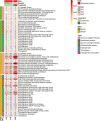Syntrophic entanglements for propionate and acetate oxidation under thermophilic and high-ammonia conditions
- PMID: 37679429
- PMCID: PMC10579422
- DOI: 10.1038/s41396-023-01504-y
Syntrophic entanglements for propionate and acetate oxidation under thermophilic and high-ammonia conditions
Abstract
Propionate is a key intermediate in anaerobic digestion processes and often accumulates in association with perturbations, such as elevated levels of ammonia. Under such conditions, syntrophic ammonia-tolerant microorganisms play a key role in propionate degradation. Despite their importance, little is known about these syntrophic microorganisms and their cross-species interactions. Here, we present metagenomes and metatranscriptomic data for novel thermophilic and ammonia-tolerant syntrophic bacteria and the partner methanogens enriched in propionate-fed reactors. A metagenome for a novel bacterium for which we propose the provisional name 'Candidatus Thermosyntrophopropionicum ammoniitolerans' was recovered, together with mapping of its highly expressed methylmalonyl-CoA pathway for syntrophic propionate degradation. Acetate was degraded by a novel thermophilic syntrophic acetate-oxidising candidate bacterium. Electron removal associated with syntrophic propionate and acetate oxidation was mediated by the hydrogen/formate-utilising methanogens Methanoculleus sp. and Methanothermobacter sp., with the latter observed to be critical for efficient propionate degradation. Similar dependence on Methanothermobacter was not seen for acetate degradation. Expression-based analyses indicated use of both H2 and formate for electron transfer, including cross-species reciprocation with sulphuric compounds and microbial nanotube-mediated interspecies interactions. Batch cultivation demonstrated degradation rates of up to 0.16 g propionate L-1 day-1 at hydrogen partial pressure 4-30 Pa and available energy was around -20 mol-1 propionate. These observations outline the multiple syntrophic interactions required for propionate oxidation and represent a first step in increasing knowledge of acid accumulation in high-ammonia biogas production systems.
© 2023. The Author(s).
Conflict of interest statement
The authors declare no competing interests.
Figures




References
-
- WBA. The contribution of anaerobic digestion and biogas towards achieving the UN Sustainable Development Goals. World Biogas Association. 2018. World Biogas Association (WBA), London; Available at: https://www.worldbiogasassociation.org/wp-content/uploads/2018/12/WBA_SD....
-
- De Vrieze J, Verstraete W. Perspectives for microbial community composition in anaerobic digestion: from abundance and activity to connectivity. Environ Microbiol. 2016;18:2797–809. - PubMed
-
- Şengör SS, Ginn TR, Brugato CJ, Gikas P. Anaerobic microbial growth near thermodynamic equilibrium as a function of ATP/ADP cycle: the effect of maintenance energy requirements. Biochem Eng J. 2013;81:65–72.
-
- Westerholm M, Schnürer A. Microbial responses to different operating practices for biogas production systems. In: Banu R (ed). Anaerobic Digestion. IntechOpen. 2019. https://www.intechopen.com/chapters/65614.
-
- Gallert C, Winter J. Propionic acid accumulation and degradation during restart of a full-scale anaerobic biowaste digester. Bioresour Technol. 2008;99:170–8. - PubMed

